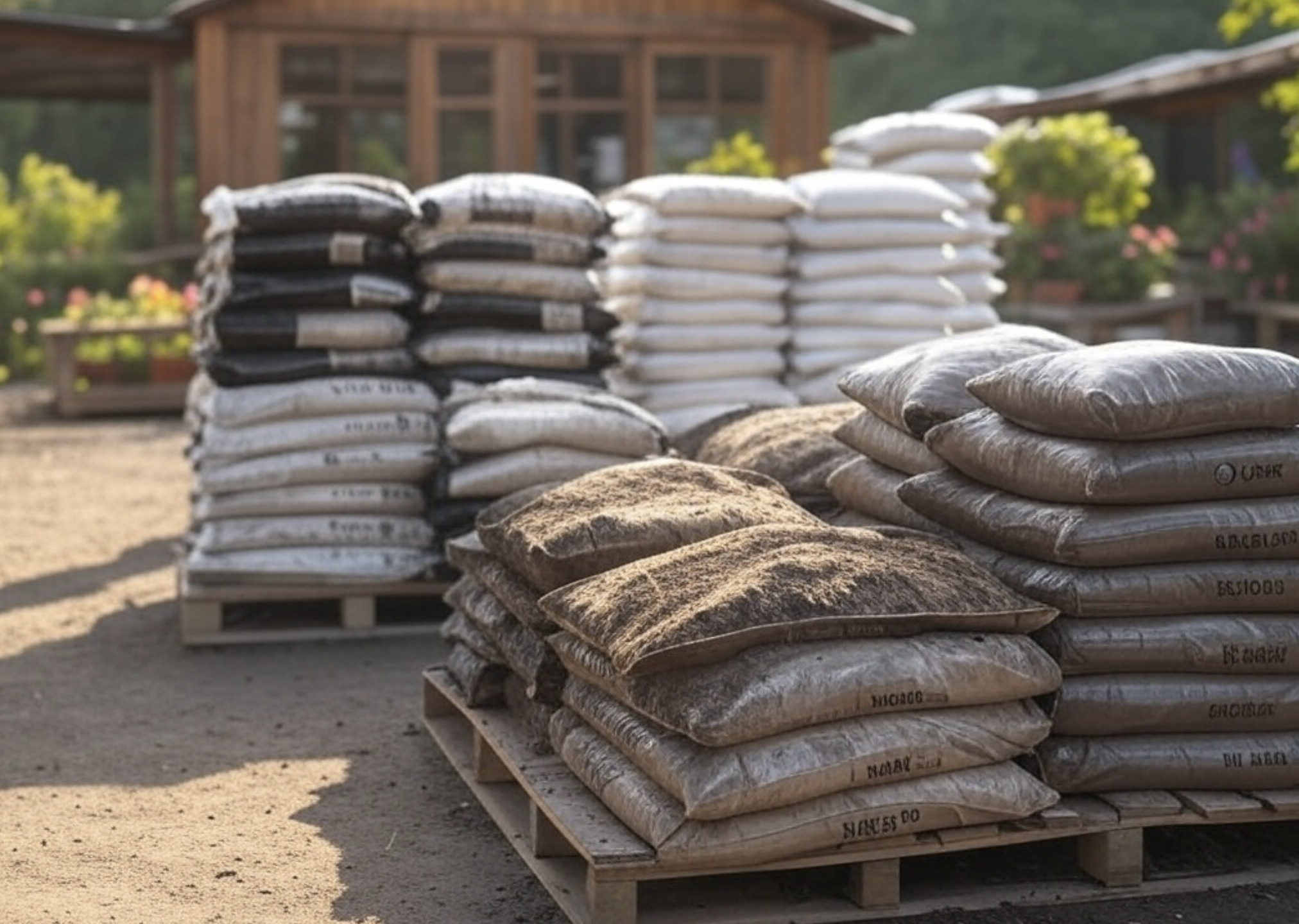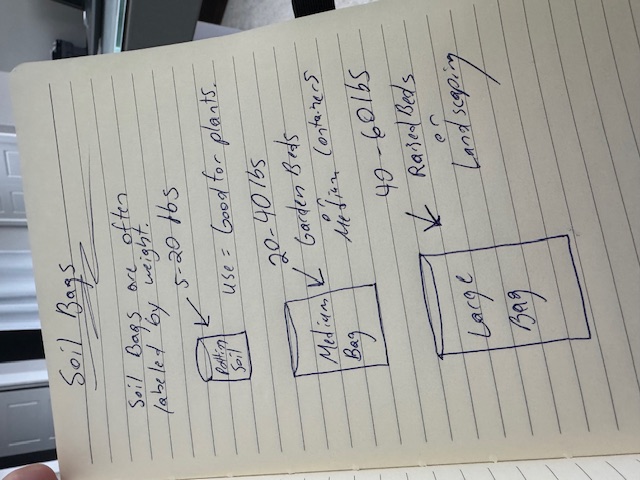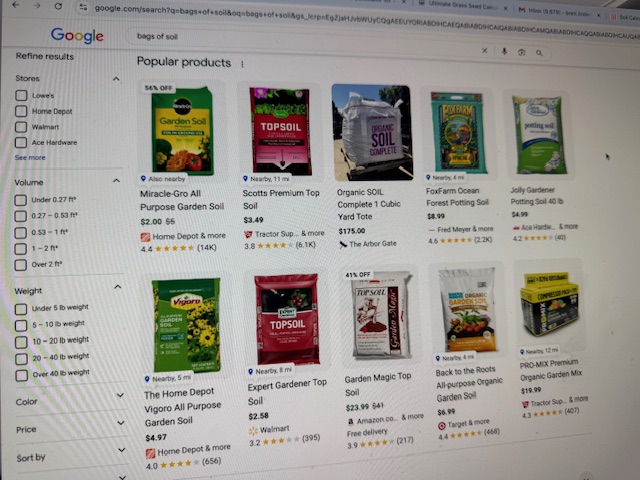Topsoil Calculator: Stop Guessing, Start Measuring.
Find out how much topsoil or dirt needed you'll need based on the size of your next project.
How to Use the Topsoil Calculator
This calculator estimates the amount of topsoil you'll need for your lawn or garden project. You can get measurements in cubic yards, tons, or bags based on the project dimensions and soil depth.
After entering all the inputs, you'll receive customized results that account for seasonal soil conditions, helping you purchase the right amount of soil.
Step 1: Choose Your Calculation Method
The calculator offers two ways to determine soil needs:
- Calculate by Dimensions: Enter the length and width of your project area.
- Calculate by Area: Enter the total square footage directly if you already know it.
Step 2: Enter Your Project Measurements
Input your project measurements using your preferred units:
- For Dimensions: Enter length and width in feet, inches, yards, or centimeters.
- For Area: Enter total area in square feet, square yards, or square meters.
- Soil Depth: Enter your desired soil depth (typically 3-6 inches for lawns, 8-12 inches for garden beds).
For irregular areas, consider breaking the space into simple geometric shapes (rectangles, triangles), calculating each separately, and adding them together. It's better to slightly overestimate than underestimate your area to ensure you have adequate soil.

Step 3: Select the Current Season
Choose the current season to adjust soil weight calculations:
- Spring: Typically wetter soil with higher moisture content and weight.
- Summer: Usually drier soil with lower weight per cubic yard.
- Fall: Moderate moisture content.
- Winter: Often frozen or highly variable moisture content depending on location.
This seasonal adjustment helps provide more accurate weight estimates, which is especially important when ordering soil by weight (tons) rather than volume (cubic yards).
Step 4: Specify Your Purchase Preference
Select how you plan to purchase your topsoil. Here are the most common options to buy dirt that I've heard about.
- Soil Bags: Convenient for smaller projects, typically sold in 40-pound bags.
- Cubic Yards: Bulk ordering by volume, common for medium to large projects.
- Tons (Weight): Bulk ordering by weight, varies based on soil moisture and composition.
Enter your local pricing information to calculate the total project cost. The calculator provides industry-standard default values provided by Lawn Love estimating $10 - $50 per cubic yard of topsoil nationally. Of course, finding your local prices will give you the most accurate estimate. The specific soil type you choose also influences cost.
Step 5: Calculate and Review Results
Click "Calculate Soil" to generate your results, which include:
- Total topsoil needed in cubic yards
- Weight estimates (dry loose, dry packed, and moist soil)
- Number of bags needed (if purchasing bagged soil)
- Estimated total cost based on your inputs
- Seasonal considerations for soil handling
You can copy these results to clipboard for easy reference when purchasing materials.
Practical Example: New Garden Bed Project
Let's walk through a practical example to see how the calculator works.

Garden Bed Topsoil Example
Project Details
- Dimensions: 10 feet × 20 feet = 200 square feet
- Desired Soil Depth: 6 inches
- Season: Spring
- Purchase Type: Cubic Yards
- Cost per Cubic Yard: $25
Calculation Results
Soil Volume Needed
- Area: 200 sq ft
- Depth: 0.5 ft (6 inches)
- Volume: 100 cubic feet
- Cubic Yards: 3.7 cubic yards (100 ÷ 27)
Weight & Cost
- Weight (Spring, Moist): 4.44 tons
- Cost: $92.50 (3.7 cubic yards × $25)
- Equivalent in Bags: ~167 bags (40 lb each)
Spring Season Consideration
Spring soil is often wetter and heavier due to seasonal rainfall. When buying in bulk, expect soil to be on the heavier side (closer to the moist weight estimate). This could affect delivery costs and handling difficulty.
Understanding Topsoil Measurements
Topsoil is typically measured and sold in these units:
| Measurement | Typical Usage | Notes |
|---|---|---|
| Cubic Yards | Bulk deliveries | 1 cubic yard = 27 cubic feet |
| Tons | Bulk deliveries by weight | Weight varies based on moisture content |
| 40-lb Bags | Small projects | Approx. 0.5 cubic feet per 40-lb bag |
One cubic yard of topsoil typically covers (the calculator does this math for you):
- 324 square feet at 1 inch depth
- 162 square feet at 2 inches depth
- 108 square feet at 3 inches depth
- 81 square feet at 4 inches depth
- 65 square feet at 5 inches depth
- 54 square feet at 6 inches depth

How the Calculator Works
Here are the formulas and calculations used to determine how much topsoil you need.
Core Volume Calculations
| Calculation | Formula | Example |
|---|---|---|
| Area from Dimensions | Length × Width (converted to sq ft) | 10 ft × 20 ft = 200 sq ft |
| Volume in Cubic Feet | Area (sq ft) × Depth (ft) | 200 sq ft × 0.5 ft = 100 cubic feet |
| Volume in Cubic Yards | Cubic Feet ÷ 27 | 100 cubic feet ÷ 27 = 3.7 cubic yards |
| Number of Bags | (Cubic Yards × 1800) ÷ Bag Size (lbs) | (3.7 × 1800) ÷ 40 = 166.5, rounded to 167 bags |
| Project Cost | Depends on purchase method | 3.7 cubic yards × $25 = $92.50 |
Seasonal Weight Adjustment Calculations
The calculator uses seasonal factors to adjust soil weight estimates based on typical moisture content for each season:
| Season | Dry, Loose Factor | Dry, Packed Factor | Moist Factor | Reasoning |
|---|---|---|---|---|
| Spring | 0.7 tons/yd³ | 0.95 tons/yd³ | 1.2 tons/yd³ | Higher rainfall and moisture content |
| Summer | 0.6 tons/yd³ | 0.9 tons/yd³ | 1.15 tons/yd³ | Drier conditions lower weight |
| Fall | 0.65 tons/yd³ | 0.9 tons/yd³ | 1.15 tons/yd³ | Moderate moisture content |
| Winter | 0.75 tons/yd³ | 1.0 tons/yd³ | 1.25 tons/yd³ | Often frozen or very wet |
Weight Calculation Formula:
Weight (tons) = Cubic Yards × Seasonal Weight Factor Example for Spring, Moist Soil:
Weight = 3.7 cubic yards × 1.2 = 4.44 tons These seasonal adjustments provide more realistic estimates because:
- Soil moisture content significantly impacts weight per cubic yard
- Wet soil can weigh up to 25% more than dry soil
- Spring soil often retains more moisture from winter precipitation
- Summer soil in many regions is drier due to heat and evaporation
- Frozen winter soil can be significantly heavier in cold climates
Unit Conversions
The calculator handles various measurement units with these conversion factors:
- Length Conversions:
- 1 foot = 12 inches
- 1 yard = 3 feet
- 1 foot = 30.48 centimeters
- Area Conversions:
- 1 square yard = 9 square feet
- 1 square meter = 10.764 square feet
- Volume Conversions:
- 1 cubic yard = 27 cubic feet
- 1 cubic yard = ~54 bags (40 lb each)*
* This varies based on soil density and moisture content
Recommended Soil Depth
| Project Type | Recommended Depth | Notes |
|---|---|---|
| New Lawn from Seed | 4-6 inches | Provides adequate root development zone |
| Overseeding Existing Lawn | 0.25-0.5 inches | Thin layer to cover seed |
| Vegetable Garden | 8-12 inches | Deeper for root vegetables |
| Raised Beds | 10-12 inches | Fill completely unless using hugelkultur method |
| Flower Beds | 6-8 inches | Adequate for most ornamental plants |
| Tree Planting | 2-3 inches | Layer around tree after planting (not in hole) |
| Topdressing Lawn | 0.25-0.5 inches | Thin layer to improve soil structure |
I hope you enjoyed using this tool as much as I enjoyed making it for you. You might also be interested in this Grass Seed Calculator to determine the seeding rates for your new lawn after you get the dirt in.
